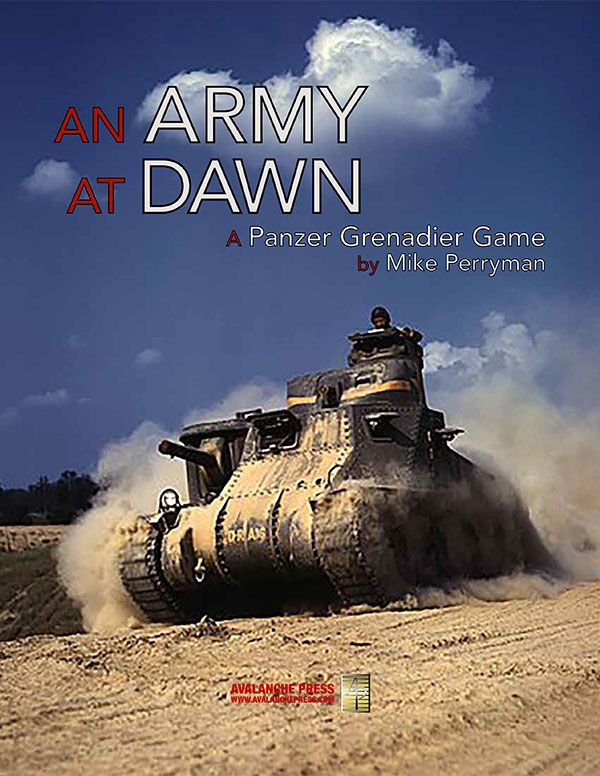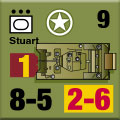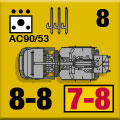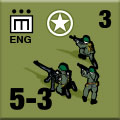| An Army at Dawn
Scenario Preview, Part Nine
By Mike Bennighof, Ph.D.
August 2024
 And now we wrap up Panzer Grenadier: An Army at Dawn, with a glimpse of what the U.S. Army would become with more aggressive leadership and less tolerance for failure. In game terms, that means better initiative and morale; sometimes even better than that of their Axis opponents. Slowly, the Americans are shedding the label stuck on them by British troops: Our Italians. And now we wrap up Panzer Grenadier: An Army at Dawn, with a glimpse of what the U.S. Army would become with more aggressive leadership and less tolerance for failure. In game terms, that means better initiative and morale; sometimes even better than that of their Axis opponents. Slowly, the Americans are shedding the label stuck on them by British troops: Our Italians.
It’s the sort of change that the Panzer Grenadier game system was built to replicate. Panzer Grenadier concentrates on the “soft factors” (leadership, morale, initiative) even though it has plenty of hardware. But that hardware still requires men to direct it, and men to fight with it.
Let’s have a glimpse at the glimpse, the game’s tenth and final chapter:
Chapter Ten
Task Force Benson
 Theater commander Dwight D. Eisenhower tolerated Lloyd Fredendall’s handling of II Corps for months after his rank incompetence and personal cowardice had become evident to every soldier in his command and most of those in allied and enemy formations. When Ike finally fired Fredendall on 5 March 1943, he flew to the corps commander’s subterranean sanctuary to personally deliver the news, gently describing it as a re-assignment. Theater commander Dwight D. Eisenhower tolerated Lloyd Fredendall’s handling of II Corps for months after his rank incompetence and personal cowardice had become evident to every soldier in his command and most of those in allied and enemy formations. When Ike finally fired Fredendall on 5 March 1943, he flew to the corps commander’s subterranean sanctuary to personally deliver the news, gently describing it as a re-assignment.
The new corps commander, George S. Patton, likewise treated Fredendall with kid gloves, but soon decided that not only had Fredendall done little to “justify his existence,” but his subordinates weren’t much better. Despite his own months-long tolerance of Fredendall’s poor and at times bizarre performance, Eisenhower told Patton that, “You must not retain for one instant any man in a responsible position where you have become doubtful of his ability to do his job.” And so, Orlando Ward of 1st Armored Division, Combat Command B’s Paul Robinett and Combat Command A’s Raymond McQuillin soon found themselves on their way home.
Patton selected the highly aggressive Colonel Clarence C. Benson lead a task force forward. Even then, Patton attached a personal representative to make sure a flame was keep lit under the colonel lest he lose his aggressiveness (and allow Patton to micro-manage the affair, in what had become a habitual fault of American higher-level commanders during this period).
Scenario Thirty-Eight
Benson Advances
30 March 1943
 The American II Corps started their effort to secure Gabes at 0600 on 28 March 28 with two infantry divisions. The 1st Infantry Division would capture Djebel el Mcheltat while the 9th Infantry Division took the Djebel Kheroua. This would allow Task Force Benson to advance over the relatively flat ground between the two rises unmolested. That was the plan. The American II Corps started their effort to secure Gabes at 0600 on 28 March 28 with two infantry divisions. The 1st Infantry Division would capture Djebel el Mcheltat while the 9th Infantry Division took the Djebel Kheroua. This would allow Task Force Benson to advance over the relatively flat ground between the two rises unmolested. That was the plan.
Conclusion
Despite Benson’s reputation for aggressive leadership, he recognized the tough situation in front of him when the task force encountered a minefield and the Italian defenders quickly destroyed five tanks and two tank destroyers. Benson pulled his men back and prepared a well-organized attack for the next day that included plentiful air and artillery support. To facilitate the attack’s progress, engineers cleared a path through the minefields just to the north of the first failed assault. The renewed attack was to start at 1600 hours, but went forward around noon.
Notes
It’s not a very big scenario, with a heavily-reinforced battalion on each side fighting over a single map. But it is a pretty intense one, with the Americans having an extremely high bar for victory that essentially requires crushing the Italian defenses (which include an absolutely deadly 90mm self-propelled anti-tank gun).
Scenario Thirty-Nine
Restless Energy
31 March 1943
 After the failure of his first attempt, Benson had arranged for more artillery and air support, and tasked his engineers with clearing a path through the Italian minefields. Patton at first expressed disappointment, and considered ordering Benson to simply smash his way through regardless of casualties, then changed his mind an approved the plan for a set-piece attack. But Benson became restless waiting for the scheduled start of the air and artillery bombardment, and ordered his men forward hours early. After the failure of his first attempt, Benson had arranged for more artillery and air support, and tasked his engineers with clearing a path through the Italian minefields. Patton at first expressed disappointment, and considered ordering Benson to simply smash his way through regardless of casualties, then changed his mind an approved the plan for a set-piece attack. But Benson became restless waiting for the scheduled start of the air and artillery bombardment, and ordered his men forward hours early.
Conclusion
Benson showed the aggression that Patton had hoped to see, when he pushed his tankers through the gaps in the minefields despite the infantry being unable to follow. The tankers pushed on to the foothills before a counterattack hauled all forward progress. The infantry held their ground until relieved the following afternoon. The attack destroyed four dual-purpose 88mm guns as well as a number of antitank guns and six panzers. When the day started the Centauro Division was down to fourteen M14/41 tanks and two Semoventes. The day’s fighting cost them six of their remaining M14/41’s while the carristi claimed nine American Lee tanks.
Notes
We finally get Patton into the game, at least an action inspired by Patton even though he wasn’t present himself. The Americans have a slight edge in numbers and a bigger one in armor, but they also have tough victory conditions and the Germans have an 88mm gun.
Scenario Forty
April Fools’ Battle
1 April 1943
 The previous day had seen the American reach but not clear the foothills as hoped. Despite Benson’s seeming recklessness, only eight tanks had been lost and four of these would be returned to service in short order. To hold those limited gains, the 3rd Battalion of the 13th Armor Regiment replaced the 2nd Battalion in the front lines. To drive the Americans back, the Germans used more of the arriving 21st Panzer Division in addition to a strong Air Force presence. The previous day had seen the American reach but not clear the foothills as hoped. Despite Benson’s seeming recklessness, only eight tanks had been lost and four of these would be returned to service in short order. To hold those limited gains, the 3rd Battalion of the 13th Armor Regiment replaced the 2nd Battalion in the front lines. To drive the Americans back, the Germans used more of the arriving 21st Panzer Division in addition to a strong Air Force presence.
Conclusion
With the rest of 21st Panzer Division now present on the battlefield, the Germans applied strong pressure against Task Force Benson. The 1st Armored Division was no longer the inexperienced unit that had landed in North Africa (and had the benefit of Patton’s wholesale sacking of its upper leadership); and gave some ground but extracted a price from the Germans in exchange. This concluded the Americans’ effort to force the pass. In a few days the Germans would pull back on their own as their position here had become untenable.
Notes
This is a brand-new scenario, with the Germans on the attack. Their mission is to chew up as many American units as possible; the Americans are out to avoid getting chewed – and they have a strong force with good armor and anti-tank elements to help them do that.
And that’s it for An Army at Dawn.
You can order An Army at Dawn right here.
Big Red Package
An Army at Dawn
Big Red One
Retail Price: $92.98
Package Price: $85
Gold Club Price: $68
You can order the Big Red Package right here.
Sign up for our newsletter right here. Your info will never be sold or transferred; we'll just use it to update you on new games and new offers.
Mike Bennighof is president of Avalanche Press and holds a doctorate in history from Emory University. A Fulbright Scholar and NASA Journalist in Space finalist, he has published a great many books, games and articles on historical subjects; people are saying that some of them are actually good.
He lives in Birmingham, Alabama with his wife, three children, and new puppy. He misses his lizard-hunting Iron Dog, Leopold.
Daily Content includes no AI-generated content or third-party ads. We work hard to keep it that way, and that’s a lot of work. You can help us keep things that way with your gift through this link right here.
|
